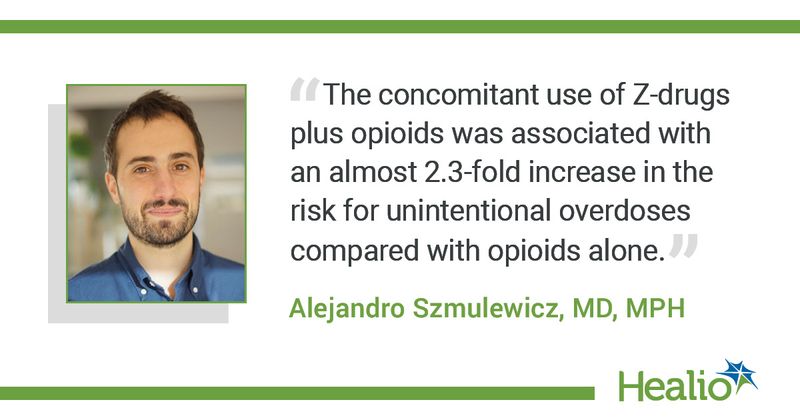Z-drugs plus opioids pose similar threat for unintentional overdose as benzodiazepines
Click Here to Manage Email Alerts
Concomitant treatment with non-benzodiazepines, or Z-drugs, was linked to a significant relative increase in overdose risk in patients receiving prescription opioids, according to study results published in American Journal of Psychiatry.
In the population-based cohort study, researchers found that the association remained after controlling for all confounding factors.

“In 2016, the FDA issued a black box warning against the co-prescription of opioids and other psychotropic medications, such as hypnotics (benzodiazepines and Z-drugs), antipsychotics and gabapentinoids,” Alejandro Szmulewicz, MD, MPH, of the department of epidemiology at Harvard T.H. Chan School of Public Health, told Healio Psychiatry. “While there is substantial evidence that the concomitant use of opioids and benzodiazepines is associated with an increased risk for overdose, which motivated an FDA black box warning, the FDA extended the warning to include Z-drugs based on their pharmacological properties, but no direct evidence was available for these agents. We felt this was an area worth exploring because some physicians may perceive Z-drugs as a safer alternative to benzodiazepines but there is actually no direct evidence supporting this.”
Szmulewicz and colleagues sought to compare overdose rates among patients using opioids plus Z-drugs and patients using opioids alone. They analyzed data of 510,529 exposed patients and an equal number of matched reference patients aged 15 to 85 years receiving prescription opioids regardless of underlying indication but who did not have evidence of cancer. They obtained patient data via the IBM MarketScan database between 2004 and 2017 and matched those with concomitant exposure to Z-drugs 1:1 to those with exposure to prescription opioids alone according to opioid prescribed, morphine equivalents, number of days’ supply and hospitalization within the past 30 days. Any hospitalization or ED visit because of an overdose within 30 days, using an intention-to-treat approach, served as the primary outcome. The researchers controlled for confounding using fine stratification on the propensity score.
Results showed 217 overdose events among the exposed patients and 57 events among the reference patients, which corresponded to an unadjusted hazard ration of 3.67 (95% CI, 2.75-4.9). The researchers used fine stratification on the propensity score and found an adjusted hazard ration of 2.29 (95% CI, 1.79-2.91). They noted consistent results across sensitivity analyses.
“Our study shows that the concomitant use of Z-drugs plus opioids was associated with an almost 2.3-fold increase in the risk for unintentional overdoses compared with opioids alone, after adjusting for a wide range of potential confounders,” Szmulewicz said. “This is an increased risk similar in magnitude to that observed in the studies of benzodiazepines plus opioids compared with opioids alone (ranging between two- and five-fold increased risk). Hence, we conclude that Z-drugs should be treated as posing a similar threat of unintentional overdoses as benzodiazepines and thus should perhaps be added as a risk factor for overdose and an indication for naloxone (as it is the case for benzodiazepines).”
